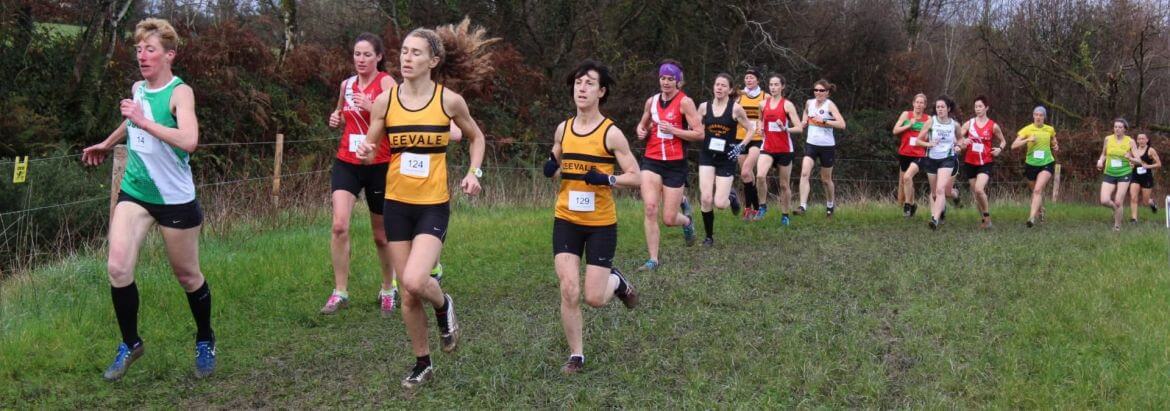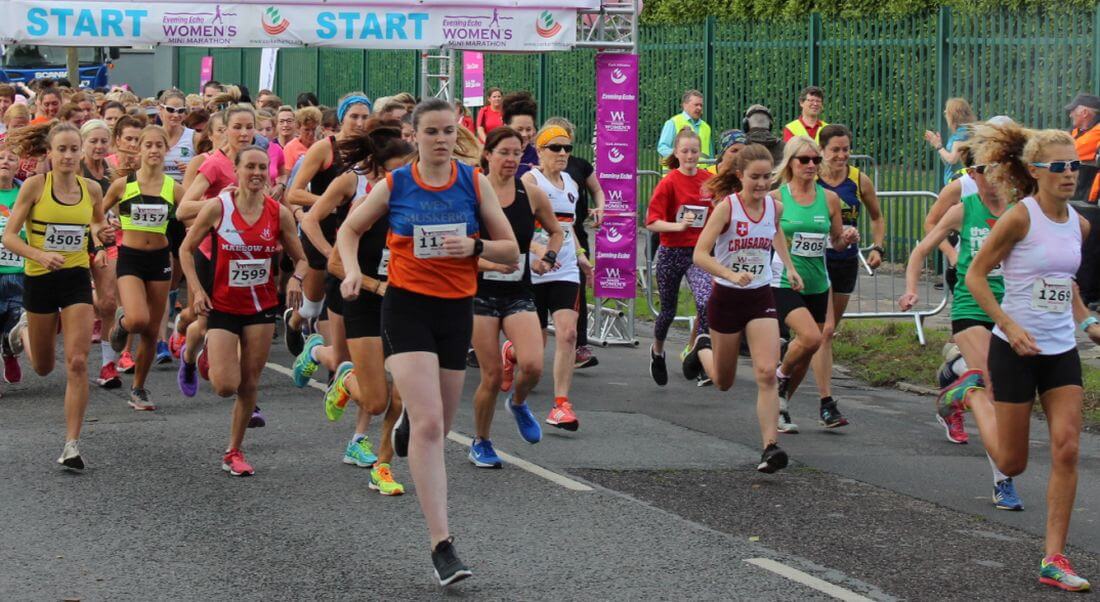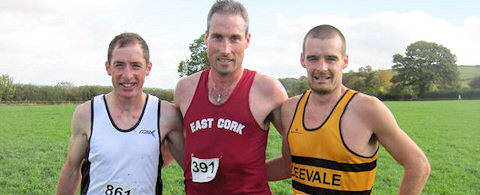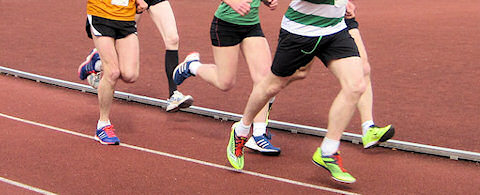Cork Athletics
Marathon Advice - On The Day
Provided by Cork Athletics Webmaster
If you are feeling unwell or have just been ill - DON'T RUN!
Most medical emergencies in the Marathon are with people who have just been, or are, unwell.
Cork Athletics Homepage
Recovering After Your Marathon
Advice For The Last Two Weeks Before Your Marathon
Last Minute Preparations
- Wear clothes that you've worn before
- Eat food that you've eaten before
- No new things the day of the marathon!
- The sleep you get two nights before the marathon is more important than the sleep you get the night before the marathon
- Don't be afraid to smear vaseline on your thighs
- Take it slowly at the beginning - run the second half of the marathon faster than the first half
- Plant supporters along the route - it gives you something to look forward to (esp. around mile 22).
- Afterwards, soak your legs in ice-cold water - does a world of good
- Protein: Burns dirty. Eat very little protein in last 24 to 36 hours, same goes for high fibre foods, otherwise you will probably need to stop for a (p)it stop in the first 10 miles or so.
- Pack your kit bag the night before.
- Don't forget any old clothes or bin liner to keep warm before the race, ready to be deposited.
- Also don't forget some goodies for when you finish the race.
It's not these 26.2 miles that are the test. It's the 500 miles leading up to them!
Eating & Drinking
Eating
Get up early and eat as soon as possible - probably best to eat about 2 to 2 1/2 hours before the start. Don't eat something which will "go through you" - like brown bread. If you've hydrated and Carboloaded properly, you need very little on the day. I'll eat about 6:30/7am and I'll have exactly the same as I have before my long runs - weetabix & yoghurt, with a very small amount of fruit, and a small bit of liquid. Eat about 300 calories that morning, 2-3 hours before the starting gun. Toast and bananas are other options. Make sure you've practiced this routine before several training runs. Beware of some sports drinks, as you will need to dilute these heavily, or you'll be making a pit stop for a crap long before you're finished.
On the morning, don't have more than a glass or two of water/isotonic drink beforehand...or you'll be making an early unscheduled pitstop
Before the Race
Toilet:
Make sure to have a crap when you wake up!! If you've eaten early, peristalisis will set in about an hour after eating and you will have to visit the loo for a dump, so timing your eating will be very important. Don't leave it too late!
Chafing
- If you're prone to chaffing it'll show up before 20 miles and you would have probably had "issues" before this point. Weather (wind, temperature and humidity ) greatly affects the liklihood of chaffing. Lots and lots of Bodyglide. I layer it on my thighs and in areas below my armpits where I regularly chafe.
- Use vaseline on your toes to prevent the blisters you get when they rub against each other. It also helps prevent blisters when it's rainy or your feet get wet for other reasons (sloppy water station technique).
- You might also want to use vaseline in 'crevices' where you might prefer not to use Bodyglide.
- If you suffer from chapped lips or cold-sores, use Chapstick. I use it on every run.
- Don't do anything that you haven't done in training.
Sun-Block
Using sun-block is a personal preference, but can be a good idea. However do NOT put sub-block on your forehead, or close to your eyes! Sweat is likely to lead to sub-block going into your eyes...and stinging like hell!
Pre-Race Wear
- Don't wear brand new shoes (but don't wear super-old ones, either). You should have run at least 50 miles in the shoes in which you plan to race.
- Many novice marathoners don't heed to the advice "don't try anything new on race day!" This means socks, cloths, shoes, gels and other products. Wear acrylic fiber socks (as cotton socks get wet and can cause blisters faster than acrylic fiber socks) and use Vaseline on any areas prone to blisters.
- Make sure you bring layers for race day, especially clothing you can discard, including a second pair of socks, gloves and a hat.
- Wear disposable layers before hand - hat/cap, raggy t-shirt, light gloves/bin bag. Keep your gloves, hat and t-shirt until you're well warmed-up, maybe for the first few miles.
Race Wear
- Don't forget your terry cloth headband, if you normally wear one. Don't wear anything that hasn't been through the wash a half dozen times.
- Try not to wear cotton. Find some of that moisture-wicking material for race day socks, shorts and sportsbra. Less chafing and moisture!
- Put your name in large letters on the front of your running vest. The crowds will encouragement! Don't over-dress for your race
- While it's crucial to stay warm and dry on the start line, once you get moving you won't want to be wearing too much clothing. Having a rain jacket and a long-sleeved top tied around your waist for over 20 miles definitely won't help your race time! Instead, wear layers that you can peel off and throw away as you get warmer during the race.
First Mile
- Sweet Jesus don't "start fast" due to the adrenaline of the race, as you'll regret it around mile 20. Start slower than you think or feel you should. Your first mile should be NO FASTER than your average intended pace. Don't be tempted to start the race quickly or waste energy weaving through the slower runners. However many you overtake, there will be many more in front of you - all for a few yards. It is better to go slow for the first mile and use this as a warm up.
- Try to get a feel for the correct pace beforehand. It is vital not to go too fast, and it is very easy to be dragged along if the initial hysteria & euphoria of the first mile or so. You can wave to your friends and supporters after the event - if you've any energy left then!
- Try to get the first mile as near as possible toyour AVERAGE goal pace. No faster!! If you are significantly slower, either sacrifice the lost time or make it up slowly. Remember the marathon is a very unforgiving race - you can't "bank" time. Go too fast and you'll pay for it. If you've something left in the tank, you can pick it up for the final few miles. In the latter stages, concentrate on picking off bodies, not miles.
- When you set off, don't think about the marathon being over 20 miles long. Break the distance down into manageable 'chunks' instead and focus on 'biting off each one as it comes. Once you reach the end of a chunk, congratulate yourself, take a drink, and a stretch if you need to, and then focus on the next chunk. This makes the distance feel a lot more achievable.
- You'll be Overdosing on adrenaline for the first five miles. This will tempt you to run faster than you want. Don't! You'll regret it later. You CANNOT 'bank' time in a Marathon! Make your goal to run the second half faster than the first
- You don't want to get stuck behind a mass of slower runners. If this happens, don't panic. Just consider it a forced moderation. Whatever you do, don't weave between slower runners. That's an excellent way to trip, or pull a groin. Be patient. Holes will eventually open up.
- Go out slow, slow, slow. You can always pick it up later on.
Pacing
Make sure you bring layers for race day, especially clothing you can discard, including a second pair of socks, gloves and a hat. If you are running the correct pace, it should feel like you are loafing for the first 6 miles or so.
Course
- Follow the shortest course! That's where it's measured - there little point in unnecessarily running 26.8 miles!
- Although you may be sharing the course with thousands of other runners, you can still use the course to your advantage. In many of the major marathons there will be a line on the ground that measures the exact race distance. Follow the course line wherever possible to ensure you are taking the most direct route to the finish line! If it's very windy out there, tuck in close behind a group of runners, so that they act as a windshield for you!
- Watch your running step! This applies particularly to the first mile when the road is littered with discarded bin liners, plastic bottles and clothing - and to drinks stations, where people move erratically. I've seen many a bruised and bloodied runner being tended to by the first aid teams before they've even got into their stride! It's quite a challenge to run in such close proximity to other people, and you need to keep your wits about you. Try to stick your hand out, like an indicator, if you intend to move sideways - and always check before you pull out in front of someone or stop.
- Strategy
- If you can, grab your drink and run through the water-station. If it's in cups, you'll need to get it down quickly or it'll spill. If it's bottles, get away from the mayhem of the station and drink at leisure. You can 'make time' by breezing thro' like this
- Work the course - (Dublin City Marathon - see the course description at the end of this article.) If you've done the work, most of the Marathon effort is in the mind. I after a 90 hour working week, ending on the Sat afternoon before Dublin, I once got thro' the race repeating to myself (not aloud) "Long, cool and easy", and visualized this
- Get some support. Know where your supporters are, and put your name on your t-shirt.
- Think while you run
- Try to stay present in your running. If you drift off into a reverie, or get too caught up in the carnival atmosphere, you may forget to hydrate properly and may not notice your pace quickening (or less likely, slowing down) until you suddenly reach the halfway point in a time that's way off target. Staying focused means you can do something about it if you do make a mistake, whereas getting so carried away that you don't even notice you've made a mistake is hard to rectify.
- Supporters
- No matter how independent you are, it really helps to have some supporters out there on the course. Whether it's a charity that you are running for, or for yourself, or for friends, family, or work colleagues - try to get as many spectators out there as possible on the day. Be very specific about where you want them to be. Remember to tell them not just at what point on the course (for example right by the seven- mile marker), but also at which side of the road. Also, them as accurately as possible at what time you expect to get to that point on the course. And the advice about putting your name on the front of your t- shirt might be old hat, but it still holds true - so do it! Hearing your name called, even by someone you hardly know, is hugely heartening when your spirits are beginning to flag and your legs feel heavy.
- If you take nothing else from this article, remember this: Learn to body scan. All you need to do is cast your mind's eye from head to toe, looking for any signs of unnecessary tension or tightness, any muscles that could do with a stretch, and any joints that could do with loosening up. I often find it's my jaw that is set solid, with a frown across my forehead. Try a smile - it's impossible to be tense and smile at the same time. I suggest doing a body scan every ten to 15 minutes, to ensure you are as relaxed as possible and not wasting energy.
- Even if you are hell-bent on breaking three, four or five hours in this race, don't keep your mind focused entirely on the finish line throughout. Instead, try to enjoy the journey as well as the destination. You've put so much into preparing for this big day, the least you should do is try to savour it a little!
- Drinking / Gels / Power Bars
- DON'T drink or eat anything that you haven't tried on your long runs - No matter how much others tell you how great they are! I did it once and, in spite of perfect training and form, blew up due to nausea from the "you've gotta take - it's brilliant!" isotonic drink.
- You have been warned! You have too much riding on this race to blow it on an untried drink/gel/bar
- Drinking: If you've followed the advice on hydration, then you'll be pretty well hydrated and will only need to drink very little on the run, just enough to keep your mouth moist. Remember if you drink too much — if you can feel water sloshing around in your stomach — you are creating a problem also = too much water is toxic! Learn to take water on the run, how to run through the water station and sip as you go
- Remember to drink before you get thirsty, and eat your energy bars (or gels or whatever you're carrying with you) before you think you need them.
- Drinking on the go can be tricky if you haven't practiced it before. Most people have success folding the cups into a V. But don't be afraid to walk through the water stations
- Drink at least a bit of water or isotonic drink at EVERY drink station. Don't wait until you feel dehydrated, or it will be too late.
- Unless you're really dehydated, or it's really hot on race day, don't stop for water in the last 2-3 miles. Your body won't absorb it fast enough 'to help much, and it can be hard to start running again once you stop.
- Watch out for idiots wearing headphones!!! - they won't hear your calls and generally cause mayhem at the waterstations!
Cooling
If the weather is hot, you might want to slosh water over your wrists and thighs. Beware, if pouring water over your head, as too much will run down your back and into your shorts, with risk of chafing.
Latter Stages
- Keep your head up. Protect your back, neck & confidence, by keeping eye contact with the crowd. Keep your head up while running. As you get tired, you may find that you are spending most of the time looking at your feet rather than up at the road ahead. This not only throws your spine out of alignment - putting you at risk of back, neck pain or shoulder tension it can also make your spirits flag, as you aren't making eye contact. Keeping your head up gives you a much more confident stance and sends a positive message to your subconscious mind.
- Resist the urge for a toilet break Talk to yourself while you run
- Give yourself a bit of a pep talk as you go along. Tell yourself how well you're doing. Tell yourself how strong you are - in mind and body. You may want to have a mantra, which you can repeat to yourself with ease as you are running. I have used 'I am running fast and strong' in the past, which has a nice rhythm to it (even if you're doing anything but!)
- Have fun! Smile and respond to the crowd. Stay focused on your race target Your target is to get to the end!
- Break the distance down into manageable 'chunks' and congratulate yourself when you finish each one.
Wind
- Wind (A): If it's windy, then shelter as much as possible; run behind someone as much as possible.Maybe take turns at breaking the wind.
- Wind (B): If you feel bloated, then FART!! If you keep it in, then it will tend to act as a sort of liquidizer on your intestine - resulting in the need for a pit-stop. So....ladies especially don't be afraid to fart - If it's noisy, blame it on the men around you - "Aren't they terrible!", if it's quiet, blame it on the men anyway!
The Finish
DO NOT STOP YOUR WATCH AT THE FINISH LINE. You will look silly in the photo. Run through it (with your arms raised in triumph if you like). Stop your watch after you pass the cameras.
The Course
SPR: Shortest Possible Route - Everywhere you can, run the SPR. That's the way the course is measured. If everyone else is taking the long way round bends, don't follow - unless you're sheltering from the wind. Why run, say, 27 miles - 26.22 is long enough as it is!

















